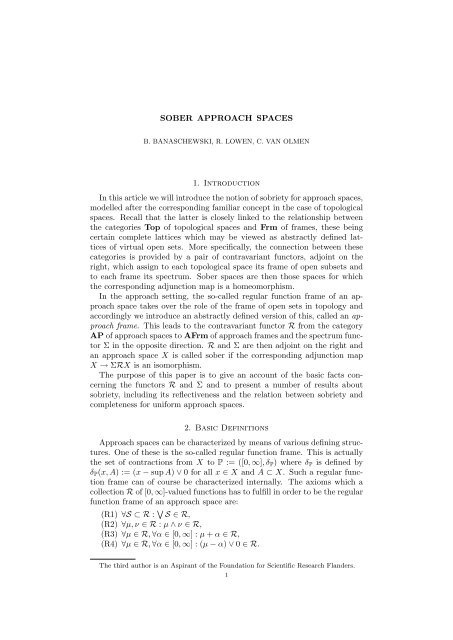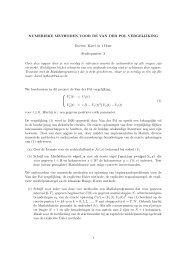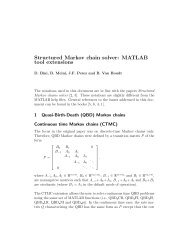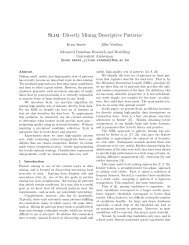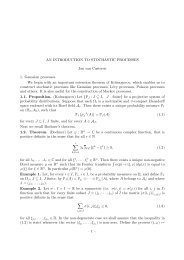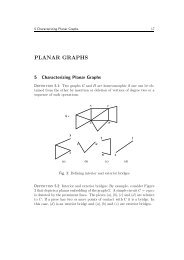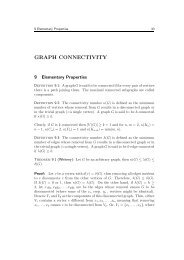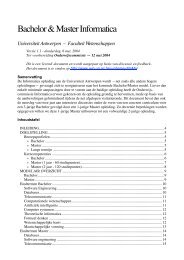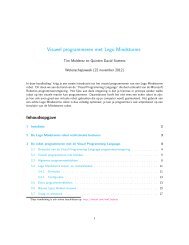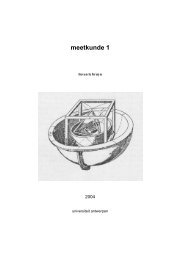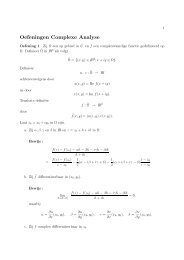SOBER APPROACH SPACES 1. Introduction In this article we will ...
SOBER APPROACH SPACES 1. Introduction In this article we will ...
SOBER APPROACH SPACES 1. Introduction In this article we will ...
You also want an ePaper? Increase the reach of your titles
YUMPU automatically turns print PDFs into web optimized ePapers that Google loves.
4 B. BANASCHEWSKI, R. LOWEN, C. VAN OLMEN3.3. Definition. We call an approach space X sober whenever ɛ X : X →ΣRX is an isomorphism.An approach frame L is said to be spatial iff η L : L → RΣL is an isomorphism.Note that <strong>this</strong> holds iff ɛ X is injective and surjective, hence <strong>we</strong> find thatX is sober iff any ξ : RX → J is an ˜x with x unique.3.4. Definition. Sob is the category of sober approach spaces and contractionsbet<strong>we</strong>en such spaces.SpAFrm is the category of spatial approach spaces and homomorphismsbet<strong>we</strong>en them.These subcategories of respectively AP and AFrm are clearly full.3.5. Proposition. R and Σ induce a dual equivalence bet<strong>we</strong>en Sob andSpAFrm.Proof. This is a formal consequence of the definitions of Sob and SpAFrm.□4. An alternative view on the spectrum4.<strong>1.</strong> Definition. We call an element a ∈ L prime iff∀b, c ∈ L : b ∧ c ≤ a ⇒ b ≤ a or c ≤ a4.2. Lemma. Prime elements are translation-stable in the sense that forany prime a ∈ L, ∀α ∈ [0, ∞[ then A α a is prime and if α ≤ a then S α a isprime.Proof. For the first claim <strong>we</strong> haveb ∧ c ≤ A α a ⇔ S α (b ∧ c) ≤ a ⇔ S α b ≤ a or S α c ≤ a ⇔ b ≤ A α a or c ≤ A α a.The second claim goes analogously.We can even give a stronger result:4.3. Lemma. <strong>In</strong> any approach frame L, any prime a is a translation of aprime b with the property λ ≤ b ⇒ λ = 0.Proof. For any prime a ∈ L, put λ a = ∨ {α|α ≤ a}. Then λ a ≤ a by thedefinition of approach frames. Now suppose µ ≤ S λa a, then for ν = µ + λ a ,ν ≤ A λa S λa a = a ∨ λ a = a, which gives us µ + λ a ≤ λ a and therefore µ = 0.Hence u = S λa a is a prime for which λ ≤ u implies λ = 0 and a = A λa u. □Using these two lemmas, <strong>we</strong> see that any prime element is accompaniedby a [0, ∞[-indexed family of “translated” prime elements and there is aspecial role for primes a with λ ≤ a ⇒ λ = 0.4.4. Definition. We call an element a ∈ L approach prime iff a is primeand λ ≤ a implies λ = 0.4.5. Proposition. If ξ : L → J is a homomorphism then ξ ∗ (0) = ∨ {x|ξ(x) =0} is approach prime. Conversely, if a ∈ L is approach prime, then ξ a : L →J with ξ a (x) := ∧ {α|x ≤ A α a} is a homomorphism. Moreover, ξ ξ∗(0) = ξand (ξ a ) ∗ (0) = a.□
<strong>SOBER</strong> <strong>APPROACH</strong> <strong>SPACES</strong> 5Proof. For the first claim, put a := ∨ {x|ξ(x) = 0}, then obviously ξ(a) = 0.If b ∧ c ≤ a, then by monotonicity ξ(b) ∧ ξ(c) = ξ(b ∧ c) = 0, hence eitherξ(b) = 0 or ξ(c) = 0. Finally, if α > 0 is such that α ≤ a, then ξ(α) ≤ξ(a) = 0 which is a contradiction.To prove the second claim, note that ξ is clearly order-preserving and thatξ a (0) = 0. Suppose that ξ a (∞) ≠ ∞, then there exists an α ∈ ]0, ∞[ suchthat ∞ = A α a. Consequently 2α ≤ A α a, and thus α = S α 2α ≤ a which isa contradiction.If S ⊂ L then <strong>we</strong> find that∨ ∨S ≤ A ξa(s)a = A W ξ a(S)as∈Sand hence that ξ a ( ∨ S) ≤ ∨ ξ a (S). Since ξ is monotone, <strong>we</strong> have the otherinequality and so <strong>we</strong> find that ξ commutes with arbitrary joins.ξ a (x ∧ y) = ξ a (x) ∧ ξ a (y): since ξ is order-preserving, <strong>we</strong> find ξ(x ∧ y) ≤ξ(x) ∧ ξ(y). For the other inequality: suppose that x ∧ y ≤ A α a. Bylemma ??, <strong>we</strong> find that x ≤ A α a or y ≤ A α a.ξ a (A α x) = ξ a (x) + α: take ξ a (x) = β, then x ≤ A β a ⇔ A α x ≤ A β+α a ifα < ∞. With α = ∞, the result is immediate.ξ a (S α x) = (ξ a (x) − α) ∨ 0: S α x ≤ A β a ⇔ x ≤ A α+β a.□4.6. Corollary. The space of points of L can be expressed as the set ofapproach prime elements. We denote <strong>this</strong> set by aprim(L).4.7. Definitions and Notations. We <strong>will</strong> use p ξ for the approach primeelement associated with the homomorphism ξ : L → J.For the homomorphism associated with the approach prime element a, <strong>we</strong><strong>will</strong> use h a .Using <strong>this</strong> definition <strong>we</strong> can easily express the approach structure onaprim(L). This must still be L, but the construction is slightly differentnow:∀f ∈ L, a ∈ aprim(L) : f(a) = h a (f)The distance δ on the spectrum can be constructed explicitly. First rememberthe relation bet<strong>we</strong>en the distance and the regular function frame inan approach space X:δ(x, A) = sup{ρ(x)|ρ ∈ R, ρ| A = 0}4.8. Proposition. On ΣL, the distance is defined as:δ(ξ, A) = ∨ {ξ(a)|a ∈ L, ∀ζ ∈ A : ζ(a) = 0}If <strong>we</strong> work with aprim(L), <strong>this</strong> givesδ(a, A) = h a ( ∧a i )a i ∈AProof. The formula on ΣL is an easy translation of the relation bet<strong>we</strong>enregular function frames and the distance.For aprim(L), note that h ai (b) = 0 iff b ≤ a i . It now follows that thelargest element of L that has evaluation 0 for all h ai must be ∧ a i . □
6 B. BANASCHEWSKI, R. LOWEN, C. VAN OLMEN5. Sobriety<strong>In</strong> <strong>this</strong> section <strong>we</strong> <strong>will</strong> (briefly) study the property of sobriety and <strong>this</strong><strong>will</strong> include a very nice characterization of the spectrum of uniform spaces.Note that being sober is also equivalent to the fact that every approachprime of RX is of the form (˜x) ∗ (0) = ∨ {ζ ∈ RX|ζ(x) = 0} = δ {x} for aunique x.Also note that sobriety in the classical frame sense can be defined likewise.<strong>In</strong> further analogy with frame theory <strong>we</strong> find counterparts of two of the basicproperties concerning sobriety: the spectrum of a frame L is sober and therelation bet<strong>we</strong>en morphisms bet<strong>we</strong>en spaces and their corresponding frames.5.<strong>1.</strong> Lemma. Every ΣL is sober.Proof. We already know that (Ση L ) ◦ ɛ ΣL = Id ΣL . On the other hand:and for any a ∈ L <strong>we</strong> have(ɛ ΣL ◦ (Ση L ))(ζ) = ɛ ΣL (ζ ◦ η L ) = (ζ ◦ η L )˜(ζ ◦ η L )˜(â) = â(ζ ◦ η L ) = (ζ ◦ η L )(a) = ζ(â)This means that (ζ ◦ η L )˜= ζ and so ɛ ΣL ◦ (Ση L ) = Id ΣRΣL . Hence <strong>we</strong> findthat ɛ ΣL is an isomorphism.□5.2. Proposition. Sobriety is reflective in AP, with the adjunction mapsɛ X : X → ΣRX as reflection maps.Proof. By the preceding lemma, if <strong>this</strong> map is an isomorphism then X issober and therefore it is an isomorphism iff X is sober.□5.3. Proposition. Take Y a sober approach space and X general. Then foreach homomorphism h : RY → RX, there exists exactly one contractionf : X → Y such that h = Rf.Proof. For any h : RY → RX, ifthenf = ɛ −1Y◦ (Σh) ◦ ɛ X : X → YRf = Rɛ X ◦ RΣh ◦ (Rɛ Y ) −1 = Rɛ X ◦ RΣh ◦ η RY = Rɛ X ◦ η RX ◦ h = hbecause of the adjunction identities and naturalness of the adjunction maps.Further, if Rf = Rg, for any f, g : X → Y , <strong>we</strong> haveand hence f = g.ɛ Y ◦ f = (ΣRf) ◦ ɛ X = (ΣRg) ◦ ɛ X = ɛ Y ◦ gIt is natural to wonder whether there is a relation bet<strong>we</strong>en sobriety in theAFrm-context and the classical notion of sobriety. The next two propositions<strong>will</strong> shed light on <strong>this</strong> relation. We <strong>will</strong> see that for topological spacesit means the same, but for general approach spaces it is a stronger construction.5.4. Proposition. If an approach space X is sober (in the approach sense)then its topological coreflection is sober (in the topological sense).□
<strong>SOBER</strong> <strong>APPROACH</strong> <strong>SPACES</strong> 7Proof. If <strong>we</strong> take A closed, join-irreducible and f, g ∈ RX, <strong>we</strong> findf ∧ g ≤ δ A ⇒ f −1 (0) ∪ g −1 (0) ⊇ A ⇒ f −1 (0) ⊇ A or g −1 (0) ⊇ A⇒ f ≤ δ f −1 (0) ≤ δ A or g ≤ δ g −1 (0) ≤ δ AThus δ A is approach prime. But since there is an isomorphism bet<strong>we</strong>en Xand ΣRX, <strong>we</strong> find that there exists a unique x ∈ X such that δ A = δ {x}and hence A = {x}.□5.5. Remark. The converse is not true, take for example (]0, 1], δ E ). Thetopological coreflection of <strong>this</strong> space is sober (even T 3 ). The spectrum ofthe approach frame of <strong>this</strong> space ho<strong>we</strong>ver is the set of all evaluations in xfor x ∈ [0, 1], since the approach prime functions are the functions f y (x) :=|x − y|. But it is interesting to note that the space that <strong>we</strong> have obtained isthe completion of the space <strong>we</strong> started with.5.6. Proposition. A topological approach space X is sober iff its associatedtopology is sober.Proof. We only need to prove that if the coreflection is sober, then everyapproach prime element is of the form δ A . This follows from proposition ??:if δ A is prime, then Ā must be join-irreducible in the set of closed sets of thecoreflection.Now take an approach prime f ∈ RX. If f is the zero-function (thusf = δ X ), there exists an element x ∈ X such that {x} = X. If f is not zero,then there exists x ∈ X such that f(x) > 0. Take ɛ > 0 such that f(x) > ɛand <strong>we</strong> find that δ(x, {f ≤ ɛ}) > 0. Since δ {f≤ɛ} ∧ (f ∨ ɛ) ≤ f <strong>we</strong> knowthat δ {f≤ɛ} ≤ f, hence ∞ ≤ δ(x, {f ≤ ɛ}) ≤ f(x). So for all finite ɛ <strong>we</strong> find{f ≤ ɛ} = {f = 0} which implies f = δ {f=0} . □5.7. Remark. Note that the above proof can be redone for approach spaceswith Imδ ⊂ {0} ∪ [m, ∞] to prove that these spaces are sober iff the topologicalcoreflection is sober.Taking a closer look at sober approach spaces, <strong>we</strong> come back to the factthat by taking ΣRX <strong>we</strong> sometimes obtain the completion of the space X. <strong>In</strong>fact <strong>we</strong> <strong>will</strong> prove that <strong>this</strong> is true for a significant class of approach spaces.First <strong>we</strong> <strong>will</strong> briefly recall some definitions and properties of approachspaces which <strong>we</strong> <strong>will</strong> need.Completeness is defined using Cauchy filters and studying their convergence.The definition of these notions follows directly from the definitionof the limit operator (notation: λ) of a filter: given an approachspace X and a filter F on X <strong>we</strong> define λF(x) = sup A∈sec(F) δ(x, A) withsec(F) = {A ⊂ X|∀F ∈ F : A ∩ F ≠ ∅}.A Cauchy filter is a filter F for which inf x∈X λF(x) = 0 and a filter forwhich <strong>this</strong> infimum is a minimum is called convergent.We can also associate another operator with filters, the so-called adherenceoperator, defined as αF(x) = sup F ∈F δ(x, F ).We also need some properties of the above concepts, namely for F, Gfilters with F ⊂ G and U an ultrafilter <strong>we</strong> have that αF ≤ αG ≤ λG ≤ λF ,
8 B. BANASCHEWSKI, R. LOWEN, C. VAN OLMENαU = λU and λF(x) ≤ δ(x, {y}) + λF(y). The proof of all these propertiescan be found in [?], section <strong>1.</strong>8.Note that in approach theory there is a very nice completion theory foruniform approach spaces, approach spaces that are subspaces of products of∞p-metric spaces.With some notions recalled, <strong>we</strong> <strong>will</strong> start by showing that there is a connectionbet<strong>we</strong>en adherence and limit operators and approach prime elements.5.8. Lemma. Take f an approach prime and F is the filter generated by{{f ≤ ɛ}|ɛ > 0}, then f = αF.Proof. Take ɛ > 0, then (f ∨ ɛ) ∧ δ {f≤ɛ} ≤ f. Since f ∨ ɛ ≰ f, <strong>we</strong> findδ {f≤ɛ} ≤ f. Hence ∨ ɛ>0 δ {f≤ɛ} ≤ f and <strong>we</strong> have that f(x) ≤ δ(x, {f ≤ ɛ})+ɛso f = ∨ ɛ>0 δ {f≤ɛ} = αF.□5.9. Proposition. If f is approach prime then there exists an ultrafilterU ⊃ F such that f = λU (consequently U is a Cauchy filter).Proof. It is clear that f ≤ λU for all ultrafilters U ⊃ F.Suppose that for all those ultrafilters f ≠ λU then∀U ⊃ F, ∃x U ∈ X : f(x U ) < λU(x U ) = sup δ(x U , U)U∈UHence∀U ⊃ F, ∃x U ∈ X, ∃U U ∈ U : f(x U ) < δ(x U , U U )which implies that ∀U U ∈ U : δ UU ≰ f.Now there exist U 1 , . . . , U n ⊃ F and U U1 ∈ U 1 , . . . , U Un ∈ U n such that∪ n i=1 U U i∈ F.Ho<strong>we</strong>ver thennmin δ U Ui= δ ∪ ni=1 i=1 U Ui ≰ fsince f is prime. We know ho<strong>we</strong>ver that f = αF = sup F ∈F δ F so <strong>this</strong> givesa contradiction. Thus ∃ U ⊃ F ultra, f = λU.U is also Cauchy since inf x∈X f(x) = 0.□5.10. Remark. The converse of <strong>this</strong> proposition is not true, the limit operatorof a Cauchy ultrafilter isn’t necessarily approach prime.<strong>In</strong> a topological space, the Cauchy filters are convergent and λU is approachprime iff lim U is a join-irreducible closed set. Thus take X := R ⊔ Rwith the topology generated by the following neighborhoods:V((x, 1)) := 〈 {V × {1}|V ∈ V(x)} 〉V((x, 2)) := 〈 {(x, 2)} ∪ (V × {1}\{(x, 1)})|V ∈ V(x)} 〉This topology is T 1 . Choose an ultrafilter U ⊃ V((x, 1)) ∨ V((x, 2)), thenlim U = {(x, 1), (x, 2)} which is not a join-irreducible closed set.Since the converse is not true in general, <strong>we</strong> <strong>will</strong> limit ourselves to approachspaces where it is true.5.1<strong>1.</strong> Definition. An approach space X is called semi-separated iff allCauchy limit operators are approach prime functions.With <strong>this</strong> definition <strong>we</strong> find a first direct connection to completeness:
<strong>SOBER</strong> <strong>APPROACH</strong> <strong>SPACES</strong> 95.12. Proposition. A sober, semi-separated approach space is complete.Proof. We have that ΣRX = {λF|F Cauchy} and by sobriety <strong>we</strong> have thatevery Cauchy limit operator is equal to δ {x} for a unique x ∈ X, hence itconverges.□A typical example of a sober, semi-separated approach space is the initialspace P.The converse of the proposition is not true ho<strong>we</strong>ver. Take for example Rwith the finite complements topology. This is a complete, semi-separatedspace, but it is not sober.We <strong>will</strong> have to further limit ourselves to a smaller class of approach spacesto find a better relation bet<strong>we</strong>en sobriety and completeness. As a first stepto <strong>this</strong> smaller class <strong>we</strong> recall the notion of a supertight map from [?].We call a function ϕ : X → [0, ∞] with X an approach space supertightiff(1) ϕ : X → ([0, ∞], δ P ) is a contraction(2) inf x∈X ϕ(x) = 0(3) ∀x, y ∈ X : δ(x, {y}) ≤ ϕ(x) + ϕ(y)5.13. Lemma. Take X an approach space. A supertight map is approachprime.Proof. Take a supertight function ϕ and suppose f ∧ g ≤ ϕ. Take x ∈ X, ifg(x) ≤ ϕ(x), then for all y ∈ X <strong>we</strong> haveg(y) ≤ g(x) + δ(y, {x}) ≤ ϕ(y) + ϕ(x) + ϕ(x) = A 2ϕ(x) ϕ(y).Since inf x∈X ϕ(x) = 0, <strong>we</strong> can find an x n with ϕ(x n ) < 1 nfor all n ∈ N.For every n <strong>we</strong> have f(x n ) ≤ ϕ(x n ) or g(x n ) ≤ ϕ(x n ), so if <strong>we</strong> defineI f = {n|f(x n ) ≤ ϕ(x n )} and analogously I g then at least one of these setsis infinite. Suppose I f is infinite, then f ≤ ∧ n∈I fA 2ϕ(xn)ϕ, so f ≤ ϕ. □Again, the implication is strict, for example in P the δ {x} with x ∈]0, ∞[are approach prime but not supertight. But for an interesting class of spaces<strong>we</strong> can prove a stronger result.5.14. Proposition. Take X a uniform approach space. A function f ∈ RXis approach prime iff it is supertight.Proof. For all d ∈ G, G the gauge associated with X, <strong>we</strong> have that g x α =(α − d(·, x)) ∨ 0 is a contraction in (X, δ d ) and hence also in X. It is trivialto see that g x α ∧ S α d(·, x) = 0.Now take f approach prime and suppose ɛ > 0. Take α = f(x) + ɛ, theng x α ≰ f, hence S α d(·, x) ≤ f. Then <strong>we</strong> also findS f(x) d(·, x) = ∨ ɛ>0S f(x)+ɛ d(·, x) ≤ f.Put into other terms: d(y, x) ≤ f(y) + f(x).Since <strong>we</strong> find <strong>this</strong> result for all d ∈ G, <strong>we</strong> obtain thatδ(y, {x}) ≤ f(x) + f(y).□
10 B. BANASCHEWSKI, R. LOWEN, C. VAN OLMEN5.15. Corollary. Take X a pseudometric space. A regular function f isapproach prime iff it is supertight.From [?], <strong>we</strong> recall that an approach space X is called complemented iffit satisfies∀F ∈ F(X) : δ(x, {y}) ≤ λF(x) + λF(y)5.16. Lemma. Take X a complemented approach space. f is approach primeiff f can be written as the limit operator of a Cauchy filter.Proof. By proposition ?? <strong>we</strong> have the implication.For a complemented space <strong>we</strong> trivially find that each limit operator ofa Cauchy filter is supertight and hence by lemma ?? <strong>we</strong> find that suchfunctions are approach prime.□5.17. Proposition. Take X a complemented approach space. Then X issober iff it is complete and T 0 .Proof. ⇒ We know that ɛ X : X → ΣRX = {λF|F Cauchy} is an isomorphism.Hence every ξ λF can be written as ˜x for a unique x ∈ X. HenceλF = δ {x} , so all Cauchy filters converge. X is also T 0 since ɛ X is injective.⇐ Since X is complete every λF with F Cauchy is equal to a function δ {x}for a unique (T 0 ) x ∈ X. Hence ɛ X is a bijection. It is even an isomorphismsince the approach structure of ΣRX is evidently the same as that of X. □If <strong>we</strong> have an approach frame associated with an approach space, thenξ f (g) = sup x∈X(g(x) − f(x)). We <strong>will</strong> use <strong>this</strong> evaluation as the basis foran extension of f ∈ RX to a function ˆf in R ˆX.5.18. Theorem. Take X complemented and T 0 , then ΣRX is isomorphicto the completion of X.Proof. Take f ∈ RX and construct ˆf : ˆX → P by settingˆf(F) ={ f(x) if λF(x) = 0sup x∈X(f(x) − λF(x))if ̸ ∃y ∈ X : λF(y) = 0If <strong>we</strong> prove that ˆf is an element of R ˆX, <strong>we</strong> have an isomorphism bet<strong>we</strong>enRX and R ˆX.Take ɛ > 0 and make ¯ɛ : ˆX → X a fixed map for whichTake F ∈ ˆX and Γ ∈ 2 ˆX:¯ɛ ( V(x) ) = xλF (¯ɛ(F) ) ≤ ɛ∀x ∈ X∀F ∈ ˆXδ P(f(¯ɛ(F)), f(¯ɛ(Γ)))≤ δ(¯ɛ(F), ¯ɛ(Γ))= ˆδ(¯ɛ(F), ¯ɛ(Γ))≤ ˆδ ( V(¯ɛ(F)), {F} ) + ˆδ ( F, Γ ) + supF ′ ∈Γˆδ ( F ′ , ɛ X (¯ɛ(Γ)) )From the definition of ¯ɛ it immediately follows that both ˆδ ( V(¯ɛ(F)), {F} )and sup F ′ ∈Γ ˆδ ( F ′ , ɛ X (¯ɛ(Γ)) ) are smaller than or equal to ɛ. Hence <strong>we</strong> findthatδ P(f(¯ɛ(F)), f(¯ɛ(Γ)))≤ ˆδ( F, Γ)+ 2ɛ
<strong>SOBER</strong> <strong>APPROACH</strong> <strong>SPACES</strong> 11We can now start the calculation of δ P( ˆf(F), ˆf(Γ)).δ P( ˆf(F), ˆf(Γ))≤ δP( ˆf(F), {f(¯ɛ(F))})+ δP(f(¯ɛ(F)), ˆf(Γ))( ) ( ) (≤ δ P ˆf(F), {f(¯ɛ(F))} + δP f(¯ɛ(F)), f(¯ɛ(Γ)) + sup δ P f(¯ɛ(F ′ )), ˆf(Γ) )F ′ ∈ΓWe also have that( ) ( )δ P ˆf(F), {f(¯ɛ(F))} = ˆf(F) − f(¯ɛ(F)) ∨ 0( ( ) )= sup f(x) − λF(x) − f(¯ɛ(F)) ∨ 0x∈X( ( ) )= sup f(x) − f(¯ɛ(F)) − λF(x) ∨ 0x∈X( ( ) )≤ δ(x, {¯ɛ(F)}) − λF(x) ∨ 0supx∈X≤ λF(¯ɛ(F)) ≤ ɛand(sup δ P f(¯ɛ(F ′ )), ˆf(Γ) ) = sup inf δ (F ′ ∈ΓF ′ ∈Γ F ′′ P f(¯ɛ(F ′ )), ˆf(F ′′ ) )∈Γ(= sup inf f(¯ɛ(F ′ ()) − sup f(x) − λF ′′ (x) )) ∨ 0F ′ ∈Γ F ′′ ∈Γ= sup inf infF ′′ ∈ΓF ′ ∈Γx∈X≤ sup inf infF ′′ ∈ΓF ′ ∈Γx∈Xx∈X= sup inf λF ′′ (¯ɛ(F ′ )) ≤ ɛF ′′ ∈ΓF ′ ∈ΓSo <strong>we</strong> finally find thatand hence ˆf is a contraction.()f(¯ɛ(F ′ )) − f(x) + λF ′′ (x)∨ 0(δ (¯ɛ(F ′ ), {x} ) + δ ( x, {¯ɛ(F ′ )} ) )+ λF ′′ (¯ɛ(F ′ )) ∨ 0δ P( ˆf(F), ˆf(Γ))≤ ɛ + ˆδ( F, Γ)+ 2ɛ + ɛ5.19. Corollary. (1) Take X metric, ΣRX is the completion of X.(2) Uniform approach spaces are sober iff they are complete and T 0 .Proof. (1) <strong>In</strong> a metric space the supertight maps can be expressed aslim n→∞ d(·, x n ) with (x n ) n a Cauchy sequence.(2) All uniform spaces are complemented.□5.20. Remark. There exist complemented approach spaces that are notuniform. Take for example all Hausdorff topological spaces that are notcompletely regular.6. SpatialityRemark that in frame theory spatiality can be defined in the same way as<strong>we</strong> defined it for approach frames. Hence it seems logical that <strong>we</strong> can findresults analogous to the classical theory. The first two results are examplesof <strong>this</strong>.□
12 B. BANASCHEWSKI, R. LOWEN, C. VAN OLMEN6.<strong>1.</strong> Proposition. An approach frame is spatial iff each element is the meetof prime elements.Proof. ⇒ If the approach frame comes from an approach space, then <strong>we</strong>know that each δ(·, {x}) is prime and since f − f(x) ≤ δ(·, {x}) for allcontractions, <strong>we</strong> find that f = ∧ A f(x) δ(·, {x})⇐ Take S = {approach prime elements a}, as approach structure take Land see the elements as functions. This set of functions has all the propertiesof an regular function frame and it is clear that <strong>this</strong> approach space givesthe approach frame <strong>we</strong> started with: if a ≠ b ∈ L then there must exist anapproach prime element e such that h e (a) ≠ h e (b), suppose not, thena = ∧ e∈SA he(a)e = ∧ e∈SA he(b)e = b.Hence an approach frame is spatial iff the underlying frame is spatial.6.2. Proposition. A T 0 approach space X is a dense subspace of ΣRX.Proof. If X is T 0 then for all x ≠ y <strong>we</strong> find δ(x, {y}) > 0 or δ(y, {x}) > 0.Hence δ(·, {y}) ≠ δ(·, {x}) and since all δ(·, {y}) are prime elements, ɛ X :X → ΣRX : x ↦→ δ(·, {x}) is injective. To show that ɛ X is a subspaceembedding, <strong>we</strong> remark that the initial structure on X by ɛ X is just R sincef ◦ɛ X (x) = f(x) (f first considered as element of RX, then seen as functionon X).For the density, consider a ∈ L such that ∀x ∈ X : a(ɛ X (x)) = 0, thenobviously a = 0. Hence <strong>we</strong> find that δ(·, ɛ X (X)) = ∨ {a(·)|a ∈ L, ∀x ∈ X :a(ɛ X (x)) = 0} = 0.□6.3. Definition. An approach frame L is said to be topological iff L can beobtained as the regular function frame of a topological approach space.6.4. Proposition. L topological iff it it spatial and S λ a = a for all λ < ∞and all approach primes a.Proof.⇒ The approach prime elements a of the approach frame are:{0 y ∈ Uθ U (y) =∞ y ∉ Ufor every closed and join-irreducible (with regard to the closed sets) U.This is because an approach prime a has values below every ɛ > 0 andfor each n ∈ N there exists an x ∈ X such that a(x) > n: suppose not,∀x ∈ X : a(x) < N and ∃x ∈ X : a(x) > N − ɛ > 0, then take{a ′ a(y) a(y) ≤ N − ɛ(y)) =∞ a(y) > N − ɛ ,then a ′ ∧ (N − ɛ) ≤ a, but a ′ and N − ɛ are not smaller than a.Finally a must be of the form θ Y : suppose a takes a value r > 0 otherthan ∞, then consider T = a −1 ([0, r 2 ]), then θ T ∧ (a ∨ r 2 ) ≤ a, but θ T ≰ aand a ∨ r 2 ≰ a.⇐ Using the isomorphism bet<strong>we</strong>en aprim(L) and ΣL, <strong>we</strong> have an approachspace, but it remains to prove that <strong>this</strong> space is topological.□
<strong>SOBER</strong> <strong>APPROACH</strong> <strong>SPACES</strong> 13Take A ⊂ aprim(L) and a ∈ aprim(L), then δ(a, A) = h a ( ∧ a i ∈A a i) = ∞if a ≱ ∧ a i ∈A a i since b ≤ A α c ⇔ S α b ≤ c and S α ( ∧ a i ∈A a i) = ∧ a i ∈A a i. Andif ∧ a i ∈A a i ≤ a, then obviously δ(ξ, A) = 0.□6.5. Definition. An approach frame is metric iff it can be obtained as theregular function frame of a ∞pq-metric space.6.6. Proposition. X is metric iff arbitrary infima in RX are pointwise.Proof. ⇒ If the pointwise infimum ∧p f i is a contraction, then it is theinfimum of the f i in RX.We know f i (x) ≤ f i (y) + d(x, y) for all i, hence∧fi (x) ≤ ∧ (f i (y) + d(x, y)) = ∧ f i (y) + d(x, y)and so the pointwise infimum is an element of RX.⇐ We know ∀a ∈ A : δ(·, A) ≤ δ(·, {a}) and( ∧ δ(·, {a}) − sup( ∧ δ(·, {a}))(b)) ≤ δ(·, A).a∈Ab∈ABut since the infimum of functions is the pointwise infimum <strong>we</strong> find thatδ(·, {a}) ≤ δ(·, A) and so <strong>we</strong> have equality.□∧ pa∈A6.7. Proposition. If every ξ ∈ ΣL is a complete lattice homomorphism,then ΣL is metric.Proof. δ(ξ, A) = ξ( ∧ ζ∈A a ζ) = ∧ ξ(a ζ ) = ∧ δ(ξ, {ζ}).It is clear that with X is metric and sober, <strong>we</strong> find that all ξ : RX → Jare complete lattice homomorphisms, since every ξ is a ˜x and the infimumof functions is pointwise, so ( ∧ f i )(x) = ∧ f i (x).References[1] Adámek J., Herrlich H. and Strecker G.E., Abstract and concrete categories. New York,John Wiley, 1990.[2] Banaschewski B., A Sobering Suggestion. Lecture Notes, Cape Town, 1999.[3] Johnstone P.T., Stone Spaces, Cambridge Studies in Advanced Math. no. 3.Cambridge, Cambridge University Press, 1982.[4] Lo<strong>we</strong>n R., Approach spaces: a common supercategory of TOP and MET,Math. Nachr. 141 (1989), p. 183–226.[5] Lo<strong>we</strong>n R., Approach Spaces: the Missing Link in the Topology-Uniformity-MetricTriad, Oxford Mathematical Monographs. Oxford, Oxford University Press, 1997.[6] Lo<strong>we</strong>n R., Sioen M., A Unified Look at Completion in MET, UNIF and AP, Appl.Cat. Struct. 8 (2000), p. 447–46<strong>1.</strong>[7] Robeys K., Extensions of Products of Metric Spaces, Ph D thesis, University Ant<strong>we</strong>rp,1992.□


